How to Create the Perfect Turtle Tank (Avoid These Common Mistakes!)

This post was created with help from AI tools and carefully reviewed by a human (Muntaseer Rahman). For more on how we use AI on this site, check out our Editorial Policy.
When I first set up a turtle tank, I was sure I had everything under control—until my little guy spent more time hiding than basking.
Sound familiar?
Creating the perfect turtle habitat might seem simple, but there are a few common pitfalls that even seasoned turtle owners fall into.
Let’s break down how to avoid those mistakes and give your turtle the happy, healthy home it deserves.
Complete Equipment Checklist for Your Turtle Tank
Now that you understand the setup principles, here’s what you actually need to buy:
Tank & Structure ($100-300):
- Appropriately sized tank (40+ gallons minimum)
- Basking platform (above-tank or floating dock)
- Stand or table to support tank weight
Filtration ($100-200):
- Canister filter rated 2-3x tank volume
- Recommended: Fluval FX4 or FX6
- See all options: Filtration Systems Guide
Lighting ($80-150):
- UVB bulb (ReptiSun 10.0 T5 HO) + fixture
- Heat lamp (75-100W basking bulb) + fixture
- Light timer for 12-14 hour cycles
- Full setup guide: UVB & Basking Equipment
Heating & Monitoring ($50-100):
- Submersible water heater (150-250W for 75 gal tank)
- Digital water thermometer
- Infrared temperature gun for basking spot
- Details: Water Heater Guide
Water Treatment ($30-50):
- Seachem Prime water conditioner
- API Freshwater Master Test Kit
- Seachem Stability (beneficial bacteria)
- Complete list: Water Treatment Products
Food & Supplements ($30-50):
- Quality turtle pellets (Mazuri or Zoo Med)
- Calcium supplement with D3
- Variety foods (leafy greens, occasional protein)
- Feeding guide: Nutrition & Supplements
Maintenance Tools ($50-80):
- Gravel vacuum (Python No Spill or Aqueon)
- Algae scraper
- Fish net
- Feeding tongs
Total Setup Cost: $400-600 for quality equipment that lasts
Get the Complete Guide: Our Turtle Owner Essentials page provides detailed reviews, specific product links, and setup instructions for every item on this list. Don’t guess – get the equipment that actually works.

5 Steps To Create The Perfect Turtle Tank
Setting up a turtle tank sounds simple, but trust me, it’s easy to mess up if you’re new to it. I made a few mistakes myself when I first started, and I wish someone had given me a heads-up.
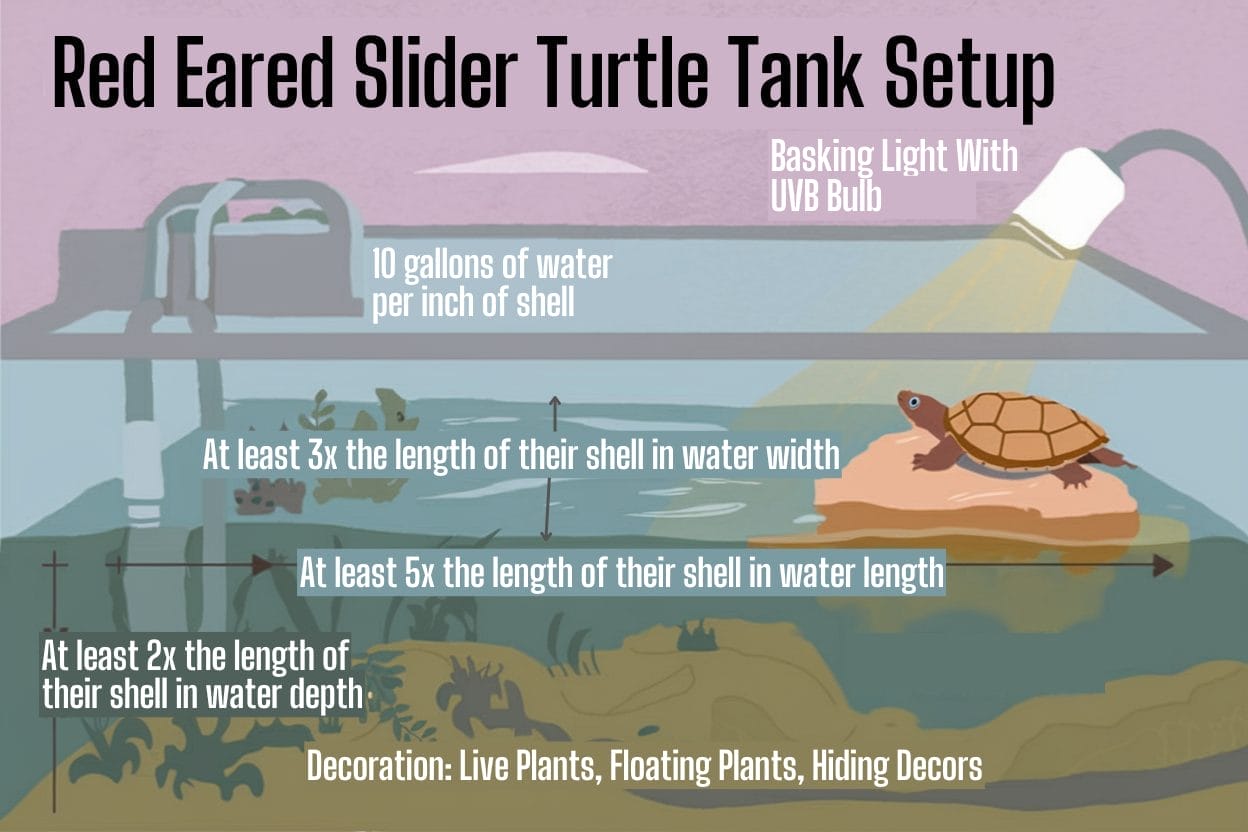
1. Tank Size and Water Volume
One of the most common mistakes people make when setting up a turtle tank is underestimating the size. I made this mistake myself when I first brought home my turtle.
I didn’t realize how much space turtles need to swim and grow, so I bought a 20-gallon tank for my little guy, thinking it’d be enough. Spoiler alert: it wasn’t. As he grew, I had to keep upgrading the tank, which got expensive and frustrating.
The general rule is 10 gallons of water per inch of shell length. So, if you have a male turtle that’s about 8-10 inches long, you’ll need a 75-gallon tank at a minimum. Females, which can grow larger, often need tanks that are 125 gallons or more.
Important: Tank size is just the foundation. Every turtle setup also requires powerful filtration, proper UVB lighting, heat lamps, water heaters, and quality food.
These equipment costs typically run $400-600 for a proper setup. Our Complete Turtle Owner Essentials guide covers exactly what equipment you need and which specific products actually work.
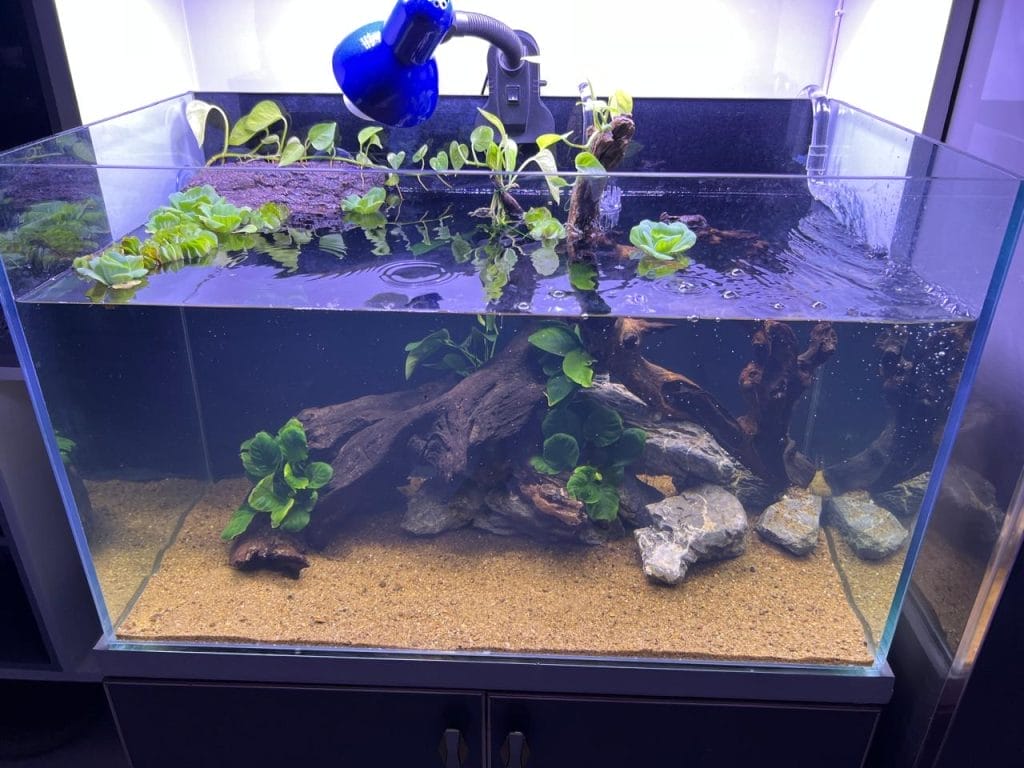
The 10-Gallon Rule Has Limits
A common rule is 10 gallons per inch of shell length, but it isn’t always enough for larger turtles.
Better Tank Size Recommendations:
| Turtle Size | Minimum Tank Size | Ideal Tank Size |
|---|---|---|
| 4-6 inches | 40-60 gallons | 75 gallons |
| 7-9 inches | 75-90 gallons | 100-125 gallons |
| 10-12 inches | 100-120 gallons | 150-200 gallons |
| 13+ inches | 125+ gallons | 200+ gallons |
Bigger is always better! A wide, long tank is better than a tall one since turtles need space to swim horizontally.
Deep vs. Shallow Water: What’s Best for Your Turtle?
Some turtles love deep water, while others need shallow areas and resting spots to prevent drowning.
Species & Recommended Water Depth
| Turtle Species | Recommended Water Depth | Notes |
|---|---|---|
| Red-Eared Slider | Deep (Tank Depth = 2x Shell Length) | Great swimmers |
| Painted Turtle | Deep (Tank Depth = 2x Shell Length) | Enjoy swimming |
| Map Turtle | Deep (Tank Depth = 2x Shell Length) | Prefer moving water |
| Musk & Mud Turtle | Shallow to Moderate (Tank Depth = 1x Shell Length) | Poor swimmers, need resting areas |
| Reeves Turtle | Shallow to Moderate (Tank Depth = 1x Shell Length) | Prefer shallow water |
Tip: If keeping a poor swimmer, add large rocks, floating docks, or driftwood so they can rest between swims.
Tank Lid and Escape Prevention
Turtles are natural escape artists! If your tank has a low water level and decorations near the edges, your turtle will try to climb out.
Even if you think the walls are high enough, turtles use their strong legs and claws to push themselves up.
How to prevent escapes:
- Use a secure mesh cover on top of your tank. This allows ventilation while stopping escapes.
- Keep the water level safe—avoid placing tall decorations near the tank’s edge.
- If using an external basking platform, make sure the walls around it prevent climbing out.
My Recommendation: You often won’t find 125 gallon tanks online. Also these cost a lot. So my tip is go to Facebook marketplace and see if anyone is selling near you. Trust me, you’ll save a lot of bucks!
Once you’ve mastered these fundamentals, explore our 11 inspiring turtle habitat designs to see how experienced keepers apply these principles creatively.

2. Filtration System
Turtles are messy—there’s no way around it. This was one of the most shocking things I discovered after setting up my first tank. Unlike fish, turtles produce a lot of waste, and if you don’t have the right filtration system, your tank will get dirty fast.
At first, I used a filter that was meant for a fish tank, and within days, the water was cloudy, and my turtle looked uncomfortable.
To avoid this, invest in a high-quality filter that’s rated for at least 2-3 times the volume of your tank.
For example, if you have a 75-gallon tank, get a filter rated for 150-225 gallons. Canister filters are ideal for turtle tanks because they’re powerful and can handle the mess. Brands like Fluval and Penn Plax are great options.
Here’s another mistake I made: I didn’t clean my filter regularly. Even with a good filter, you’ll still need to do 25% water changes every week to keep things clean. And when cleaning the filter, use tank water to avoid killing the beneficial bacteria that help maintain water quality.
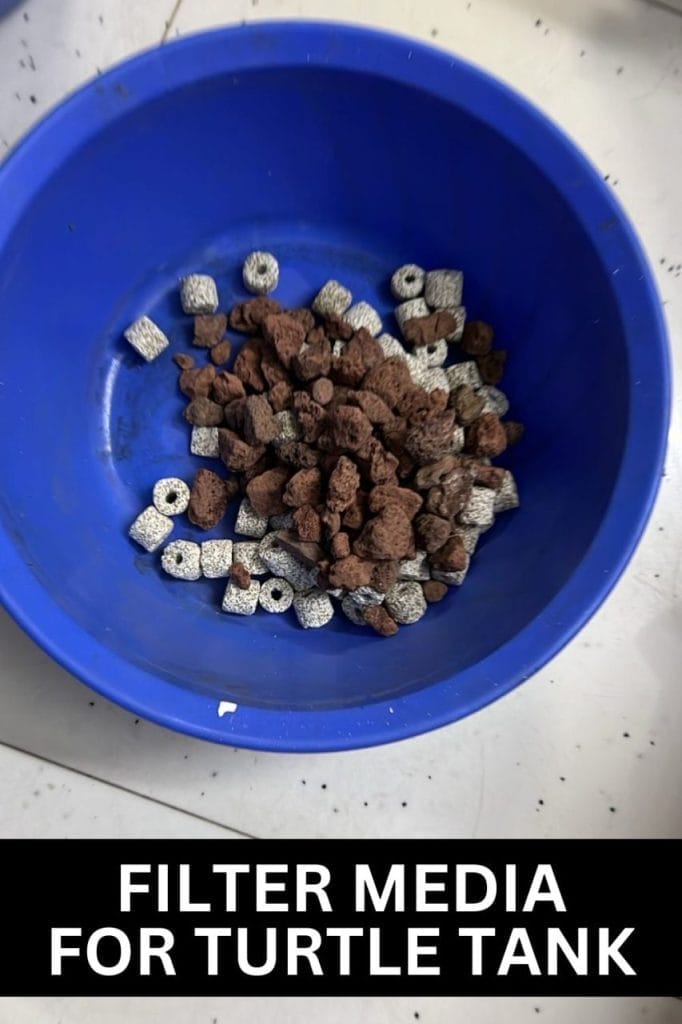
How Often Should You Change the Water?
While 25% weekly works for many tanks, it’s not a one-size-fits-all rule.
Water Change Frequency Guide:
| Tank Size | Number of Turtles | Filtration Strength | Water Change Frequency |
|---|---|---|---|
| 40-75 gal | 1 turtle | Strong filter | 25% weekly |
| 75-125 gal | 1-2 turtles | Strong filter | 15-20% weekly |
| 125+ gal | 2+ turtles | Strong filter | 10-15% weekly |
| 40-75 gal | 1 turtle | Weak filter | 40-50% weekly |
Test water parameters regularly—if ammonia or nitrate levels rise, increase water changes!

Water Flow and Turtle Comfort
A strong filter is essential, but not all turtles like powerful currents. If your turtle is constantly fighting the water flow or struggling to stay in place, you may need to adjust the filter’s output.
Species & Water Flow Preferences
| Turtle Species | Preferred Flow | Notes |
|---|---|---|
| Red-Eared Slider | Moderate to Strong | Active swimmers, handle flow well |
| Map Turtle | Moderate to Strong | Prefer moving water, natural river dwellers |
| Musk & Mud Turtles | Low | Weak swimmers, prefer calm water |
| Painted Turtle | Moderate | Enjoy some movement but not too strong |
Solution: Use a spray bar or pre-filter sponge on canister filters to reduce flow if needed.
My Top Filter Recommendations:
For most turtle tanks, you need a canister filter rated for 2-3x your tank volume. I personally use and recommend the Fluval FX4 (for 55-75 gallon setups) or FX6 (for larger tanks). The Penn-Plax Cascade 1500 is also a solid budget alternative.
These filters will last 10+ years with proper maintenance. See our detailed filtration system recommendations for specific models, sizing guides, and maintenance tips.
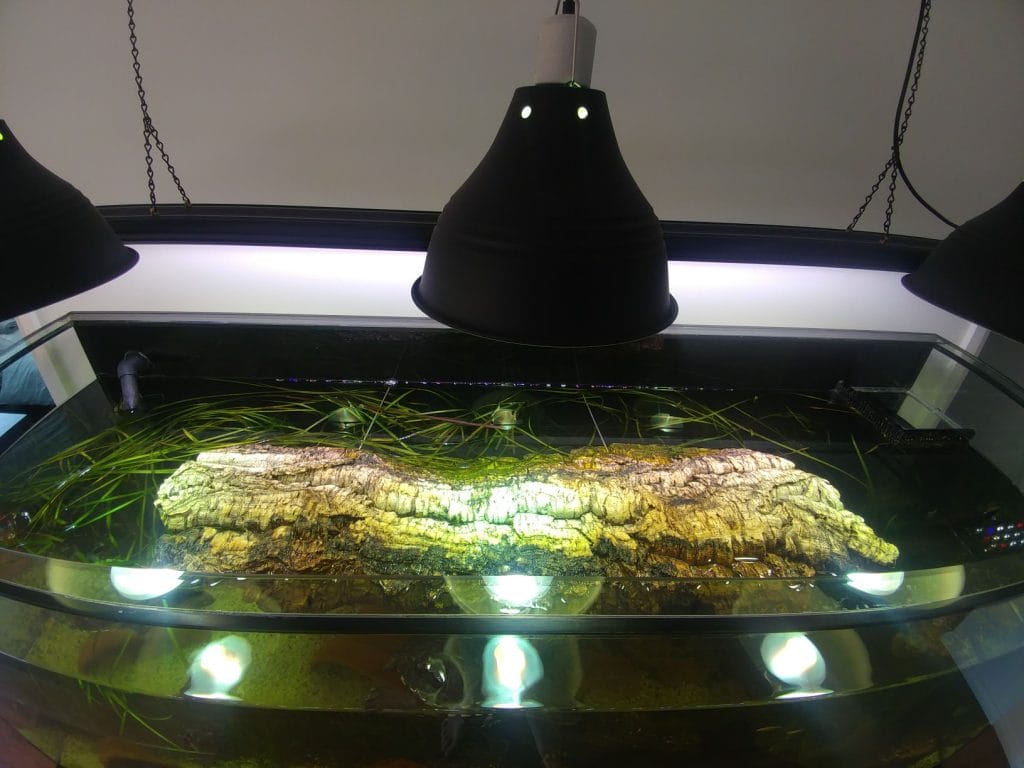
3. Basking Area
Turtles need a basking area where they can completely dry out, and this is non-negotiable. Without it, your turtle’s shell can develop health problems like shell rot.
I didn’t realize how crucial this was at first. I had a basking dock, but it wasn’t large enough or sturdy enough for my turtle to fully dry off. His shell started to look discolored, and I had to take quick action to fix the setup.
Your basking platform can be as simple or complex as you want. You can buy a ready-made dock or build one yourself using PVC pipes and mesh. Just make sure it’s sturdy enough to support your turtle’s weight—especially as they grow.

Also, place the basking area under a UVB light. Turtles need UVB rays to synthesize vitamin D3, which helps them absorb calcium and maintain a healthy shell.
Don’t forget to pair the UVB light with a heat lamp. The basking area should be between 85°F – 90°F (29°C – 32°C) to keep your turtle comfortable.

UVB Placement Matters!
A common mistake is placing a UVB bulb on top of a glass or plastic lid. UVB rays do not pass through glass or plastic, so your turtle won’t get the benefits even if the light is on.
✔ Solution: Always place the UVB directly above the basking area with no barriers.
UVB Bulb Replacement: Why It’s Crucial
Your UVB bulb might still look fine, but after 6-12 months, it stops producing enough UVB. Without UVB, turtles can’t absorb calcium properly, leading to metabolic bone disease.
UVB Maintenance Checklist:
✔ Replace bulbs every 6-12 months (check manufacturer guidelines).
✔ Avoid using glass/plastic lids—they block UVB completely.
✔ Use a UVB meter to check output if unsure.

Basking Area Must Stay Dry
If the basking platform stays damp, it can cause shell fungus.
✔ Use a platform that drains well.
✔ Monitor tank humidity—keep it below 70%.
I once forgot to replace my heat bulb when it burnt out, and my turtle became lethargic and stopped basking. It was a quick fix, but it reminded me how important maintaining the right temperature is.
Complete Basking Setup Checklist:
A proper basking area requires multiple components:
- Physical platform: Sturdy dock that supports your turtle’s weight and allows complete drying
- Heat lamp: 75-100W basking bulb positioned 8-10 inches above platform
- UVB bulb: Separate UVB fixture (ReptiSun 10.0 T5 HO) mounted 10-12 inches away
- Thermometer: Infrared temp gun to verify 88-92°F surface temperature
- Timer: Automate 12-14 hours of light daily
Our basking equipment guide covers exactly which bulbs, fixtures, and platforms to buy, plus proper positioning to keep your turtle healthy.
Critical reminder: Replace UVB bulbs every 6-12 months even if they still produce light – UVB output degrades over time.
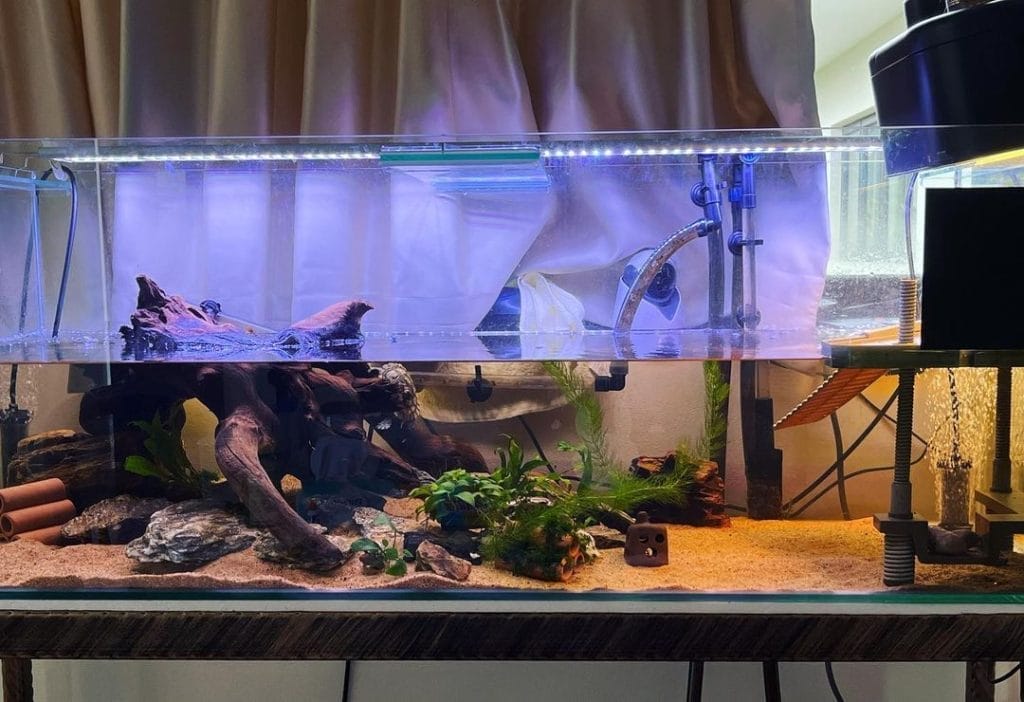
4. Substrate and Decor
Here’s a fun part—setting up the substrate and decorating the tank! When I first set up my turtle tank, I didn’t use any substrate because I read it wasn’t necessary.
But after adding some, I noticed my turtle was much more active, digging around and exploring. Substrate isn’t a must-have, but it can enhance the environment and provide enrichment.



If you decide to use substrate, go with something safe like fine sand or large river rocks that are too big for your turtle to accidentally ingest. Avoid sharp gravel or small pebbles that could be swallowed or hurt your turtle.
Working with limited funds? Our guide on building turtle habitats with recycled materials proves you don’t need expensive décor for a healthy, enriching environment.
For decorations, adding things like rocks, driftwood, and plants (either real or artificial) will give your turtle places to hide and explore. I once added some live plants to my tank, thinking it would look nice. Well, my turtle decided they were a snack, and within days, the plants were shredded.
If you go with live plants, make sure they’re turtle-safe, like java fern or anubias. Otherwise, artificial plants are a solid choice.
Check out more decoration ideas here: 28 Turtle Tank Decoration Ideas You & Your Turtle Will Love

5. Water Quality and Maintenance
Maintaining good water quality is one of the most important (and often overlooked) aspects of setting up a turtle tank. I didn’t think much about this at first and used regular tap water, which was a mistake.
Tap water contains chlorine and other chemicals that can harm turtles, so you should always use dechlorinated water or treat your tap water with a water conditioner.
Besides that, regularly checking the water parameters is crucial. Get a kit to test the pH, ammonia, and nitrite levels. Turtles are tough, but poor water quality can stress them out and lead to illnesses.
I had a period where I got lazy about water changes, and my turtle started acting sluggish. Sure enough, the ammonia levels were too high. Now, I make it a habit to test the water weekly and do small water changes regularly.
Water Quality Equipment You Need:
- Test kit: API Freshwater Master Test Kit (tests ammonia, nitrite, nitrate, pH)
- Water conditioner: Seachem Prime or API Stress Coat
- Thermometers: Digital probe thermometer for water, infrared gun for basking area
Our water treatment section covers exactly which products to buy and how often to test your water.
Here’s a table that outlines the ideal water parameters and temperature settings for pet turtles:
| Parameter | Ideal Range |
|---|---|
| Water Temperature | 75°F – 80°F (24°C – 27°C) for adult turtles 80°F – 85°F (27°C – 29°C) for hatchlings |
| Basking Area Temperature | 85°F – 90°F (29°C – 32°C) |
| pH Level | 6.5 – 8.0 |
| Ammonia | 0 ppm (parts per million) |
| Nitrite | 0 ppm |
| Nitrate | Below 40 ppm |
| Water Hardness (GH) | 100 – 200 ppm |
| Chlorine | 0 ppm (use dechlorinated water) |
Maintaining these parameters will help keep your turtle’s habitat healthy, preventing stress and illness. Remember to monitor the water regularly, as fluctuating conditions can impact your turtle’s well-being.
Essential Water Treatment Products:
Every turtle keeper needs these:
- Water conditioner: Seachem Prime (best value, detoxifies ammonia/nitrite)
- Test kit: API Freshwater Master Test Kit (liquid tests, not strips)
- Beneficial bacteria: Seachem Stability (helps cycle new tanks faster)
See our water treatment recommendations for specific brands and how to use them properly.
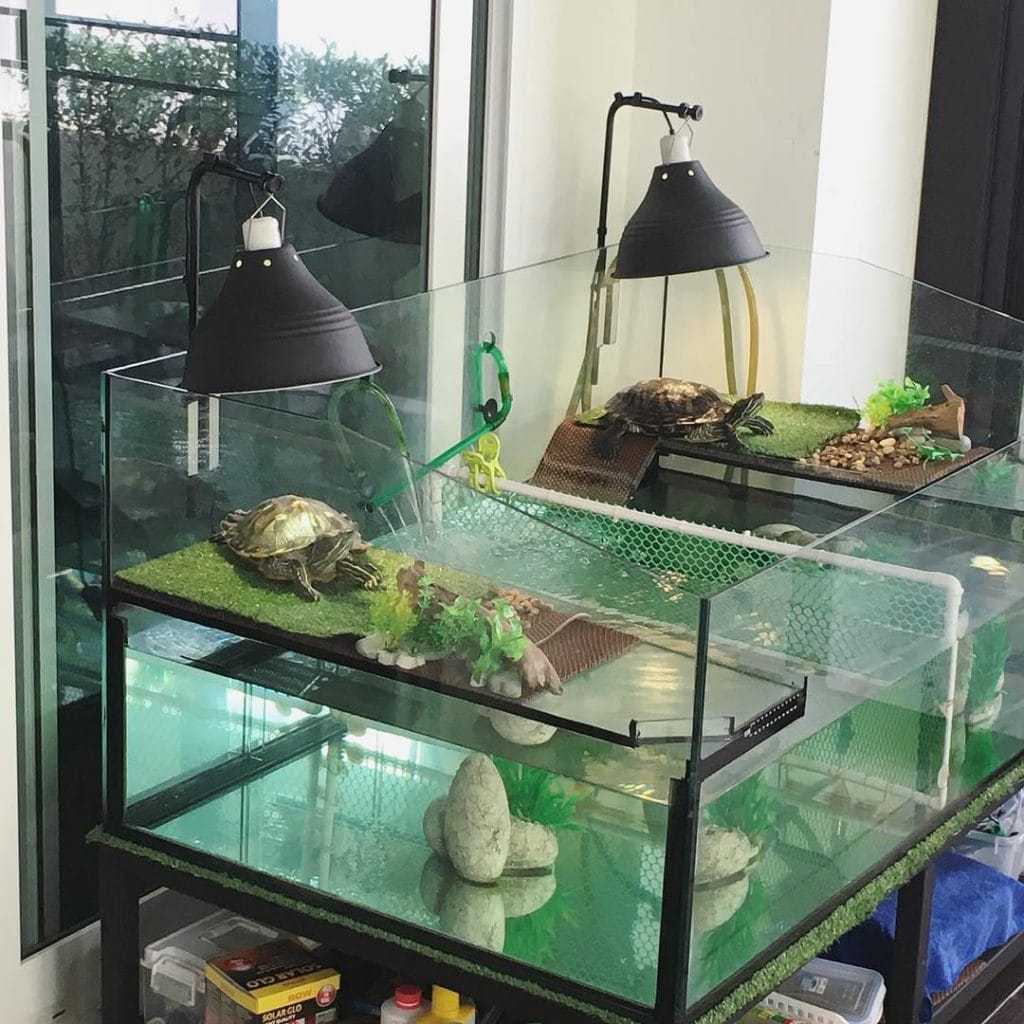
Prevent Heater Burns: Use a Heater Guard
Turtles often bump into heaters or rest against them, leading to burns.
✔ Solution: Use a heater guard or place the heater behind a barrier like driftwood.
✔ Check for burns: If you see white or black burns on the shell or skin, adjust the heater position.
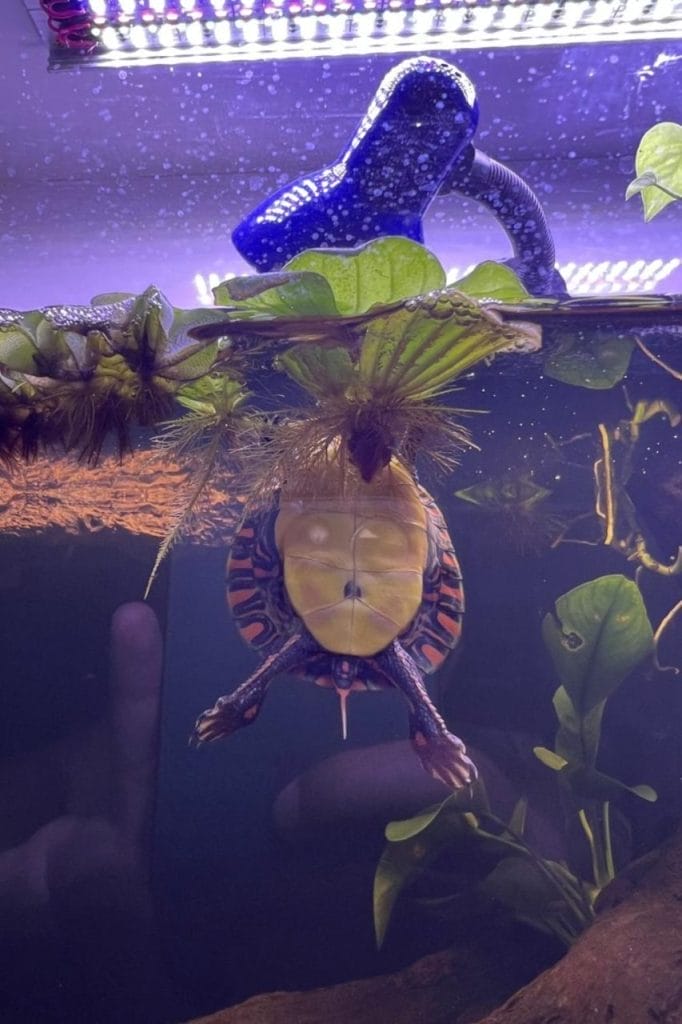
Common Mistakes to Avoid
I’ve made a lot of these mistakes myself, so here’s a quick summary to help you avoid them:
- Starting with a too-small tank: Go bigger than you think you need, especially if you have a female turtle that will grow larger.
- Using the wrong filter: Turtles are messy! Invest in a filter rated for 2-3 times your tank’s volume.
- Skipping UVB light: Don’t just use a heat lamp—UVB is critical for shell health.
- Forgetting about water quality: Always treat tap water and monitor the water parameters regularly.
- Neglecting regular maintenance: Weekly water changes and filter cleanings are essential for keeping the environment healthy.
By avoiding these mistakes and setting things up right from the start, you’ll create a thriving, healthy environment for your turtle. It may take some extra work, but trust me—it’s worth it when you see how happy and active your turtle is in its new home.
Ready to apply these principles to your specific turtle? Check our detailed guides for red-eared sliders, painted turtles, map turtles, snapping turtles, softshell turtles, or box turtles (indoor/outdoor).
Signs Your Turtle Might Be Sick
- Shell Rot: Soft spots, bad odor, or white patches on the shell.
- Respiratory Infection: Bubbles from the nose, frequent yawning, or gasping for air.
- Metabolic Bone Disease (MBD): Soft shell, difficulty moving, or deformities.
- Lethargy: If your turtle isn’t basking, swimming, or eating, something’s wrong!
What to Do: If you notice any of these, adjust the habitat and see a vet ASAP.
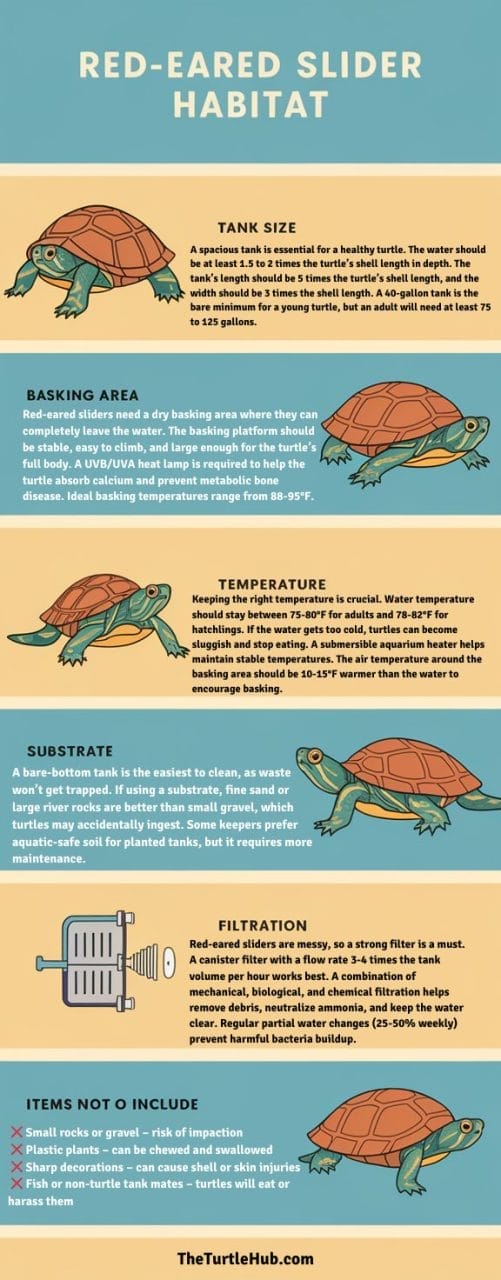
This Hilarious Turtle Book Might Know Your Pet Better Than You Do
Let’s be real—most turtle care guides feel like reading a textbook written by a sleep-deprived zookeeper.
This one’s not that.
Told from the snarky point of view of a grumpy, judgmental turtle, 21 Turtle Truths You’ll Never Read in a Care Guide is packed with sarcasm, sass, and surprisingly useful insights.
And hey—you don’t have to commit to the whole thing just yet.
Grab 2 free truths from the ebook and get a taste of what your turtle really thinks about your setup, your food choices, and that weird plastic palm tree.
It’s funny, it’s honest, and if you’ve ever owned a turtle who glares at you like you’re the problem—you’ll feel seen.
I’ve Heard These Questions A Lot!
What is the ideal tank size for my turtle?
The ideal tank size follows the rule of 10 gallons of water per inch of shell length. For instance, a male turtle that’s around 8-10 inches long would need a 75-gallon tank, while females may require a 125-gallon tank or more due to their larger size.
How often should I feed my turtle?
Adult turtles should be fed every 2-3 days, while hatchlings can be fed daily. Offer a balanced diet of commercial turtle pellets, leafy greens, and occasional protein sources like insects or fish.
The Dangers of Overfeeding
New turtle owners often feed too much protein, causing rapid growth and pyramiding (raised, bumpy shells).
Safe Feeding Guide
✔ Hatchlings: Feed daily, but in small amounts.
✔ Adults: Feed every 2-3 days.
✔ Follow the “head-sized portion” rule—only feed as much food as would fit inside your turtle’s head (excluding the neck).
Feed quality turtle pellets like Mazuri Aquatic Turtle Diet or Zoo Med Natural Aquatic Turtle Food. Dust food with calcium supplement (Rep-Cal or Zoo Med Repti Calcium with D3) 2-3 times per week.
See our nutrition guide for complete feeding instructions and supplement schedules.

How much water should I have in the tank?
You should have enough water to match the size guideline: 10 gallons per inch of shell length. This ensures your turtle has plenty of space to swim. Always make sure the water level allows for a proper basking area, so the turtle can dry off completely.
What type of filtration system do I need?
Turtles are messy, so use a high-quality filter rated for 2-3 times the volume of your tank. For example, if you have a 75-gallon tank, get a filter designed for 150-225 gallons. Canister filters are the best option because they handle waste well.
How often should I clean the tank?
Perform 25% water changes weekly to maintain water quality. Clean the filter regularly using tank water to preserve beneficial bacteria. A full tank clean is only necessary if there’s a major issue with the water quality.
Can I use tap water in my turtle tank?
Yes, but only if you treat it with a water conditioner to remove chlorine and harmful chemicals. Dechlorinated water is essential for your turtle’s health.
Tap water is safe if treated, but in some areas, it contains high chlorine, chloramine, or ammonia.
How to Make Tap Water Safe:
✔ Use a dechlorinator (removes chlorine & chloramine).
✔ Test pH—if above 8.5, it may be too alkaline.
✔ Avoid water with high ammonia—some cities use chloramine, which turns into ammonia.
If unsure, test your tap water before using!
What temperature should the water be?
The water should be between 75°F and 80°F (24°C – 27°C) for adults, and 80°F to 85°F (27°C – 29°C) for hatchlings. Keep the basking area between 85°F and 90°F (29°C – 32°C).
How much light does my turtle need?
Your turtle needs 12 hours of light each day. This includes a UVB light, which is crucial for shell health, and a heat lamp for basking. Both should be positioned over the basking area.
Is it okay to keep my turtle near a window?
No, placing a tank near a window is not ideal. Direct sunlight can cause the water temperature to fluctuate too much and promote algae growth. It’s better to control the light and temperature with UVB and heat lamps.

What should I do if my turtle’s water is cloudy?
Cloudy water is usually a sign of poor filtration or overfeeding. Check the filter, make sure you’re doing regular water changes, and avoid overfeeding your turtle.
If the water quality doesn’t improve, test for ammonia, nitrite, and nitrate levels, and adjust the cleaning routine accordingly.
If your tank is new (under 6 weeks old), cloudy water might be a bacterial bloom. This is normal and fixes itself as the tank cycles.

DO NOT:
- Change all the water—this resets the cycle.
- Overclean the filter—it removes beneficial bacteria.
Instead: Be patient and test ammonia/nitrite levels to confirm it’s cycling.
Do turtles need a basking area?
Yes, turtles absolutely need a basking area where they can completely dry off. This is crucial for preventing shell rot and other health issues. Make sure the basking area is sturdy and placed under a UVB light and heat lamp to help your turtle stay healthy.
Can I keep multiple turtles together?
Keeping multiple turtles together can be tricky. Some turtles are territorial and may become aggressive, especially in smaller tanks.
If you do want to house more than one turtle, make sure you have a very large tank (well over 125 gallons) with plenty of space for each turtle to swim, bask, and retreat to its own area.
Many turtles are territorial, and even in a large tank, they may fight over food, space, and basking areas.
What Happens When Turtles Are Housed Together?
- Aggression: One turtle may bite or push another.
- Stress: The weaker turtle may stop basking or eating.
- Injury: Serious shell damage can happen from fights.
Solution: If keeping multiple turtles, get a massive tank (200+ gallons) and have multiple basking spots. Otherwise, it’s safer to keep them separate.

Why is my tank water green?
Green water usually means an algae bloom, which is often caused by excess light, overfeeding, or poor filtration. Try to reduce the amount of light (avoid direct sunlight), clean the tank more regularly, and ensure you’re not overfeeding your turtle.
Using an algae scraper and checking water quality can help manage it.
Do I need a heater in my turtle tank?
Yes, in most cases, a water heater is essential to maintain the correct temperature, especially if the room temperature drops below what’s comfortable for your turtle.
Turtles need water temperatures between 75°F and 80°F (24°C – 27°C) for adults, or 80°F to 85°F (27°C – 29°C) for hatchlings.
Choose a submersible heater rated at 2.5-5 watts per gallon. For a 75-gallon tank, that’s a 150-250W heater.
Critical: Protect the heater from your turtle – they can crack glass heaters. Mount it behind filter pipes or use a heater guard. Our water heater guide recommends specific models and safety setups.
Does Every Turtle Need a Heater?
Most turtles need a heater, but some cool-water species can tolerate lower temperatures.
Which Turtles Need a Heater?
- Need a Heater (75-80°F): Red-Eared Slider, Painted Turtle, Map Turtle
- Can Handle Cooler Water (65-75°F): Common Snapping Turtle, Musk Turtle
💡 If room temperature drops below 70°F, use a heater to maintain stability.
What common health issues should I watch for?
Common turtle health issues include shell rot, respiratory infections, and metabolic bone disease. Shell rot can happen if your turtle doesn’t have a proper basking area to dry off.
Respiratory infections are often caused by incorrect water temperature or poor water quality. Metabolic bone disease occurs due to a lack of UVB lighting and calcium in their diet.
Always monitor your turtle for signs of lethargy, changes in appetite, or shell discoloration.

About Author
Muntaseer Rahman started keeping pet turtles back in 2013. He also owns the largest Turtle & Tortoise Facebook community in Bangladesh. These days he is mostly active on Facebook.












